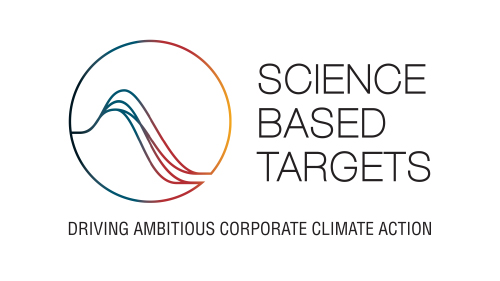Environment
Environmental Management
Sysmex Eco-Vision 2033
“Sysmex Eco-Vision 2033” Formulated
In May 2023, Sysmex formulated “Sysmex Eco-Vision 2033.” This is the long-term environmental vision that the Sysmex Group strives to achieve by 2033, in which we will take on the challenges of green innovation together with our stakeholders and utilize Sysmex's unique strengths to co-create new common standard toward the realization of a circular society. Furthermore, Sysmex has set new "Carbon Neutral Targets" with the aim of achieving zero emissions of greenhouse gases in real terms from the offices of the entire Sysmex Group by 2040.* We will continue to promote optimization of our operations and energy-saving measures. At the same time, we will implement measures to reduce greenhouse gas emissions, including a gradual switching to renewable energy-sourced electricity at our business offices.
- Applies to direct greenhouse gas emissions due to use of fuel by the company (Scope 1) and indirect greenhouse gas emissions arising from the use of electricity and heat purchased by the company (Scope 2)
Long-Term Environmental Vision
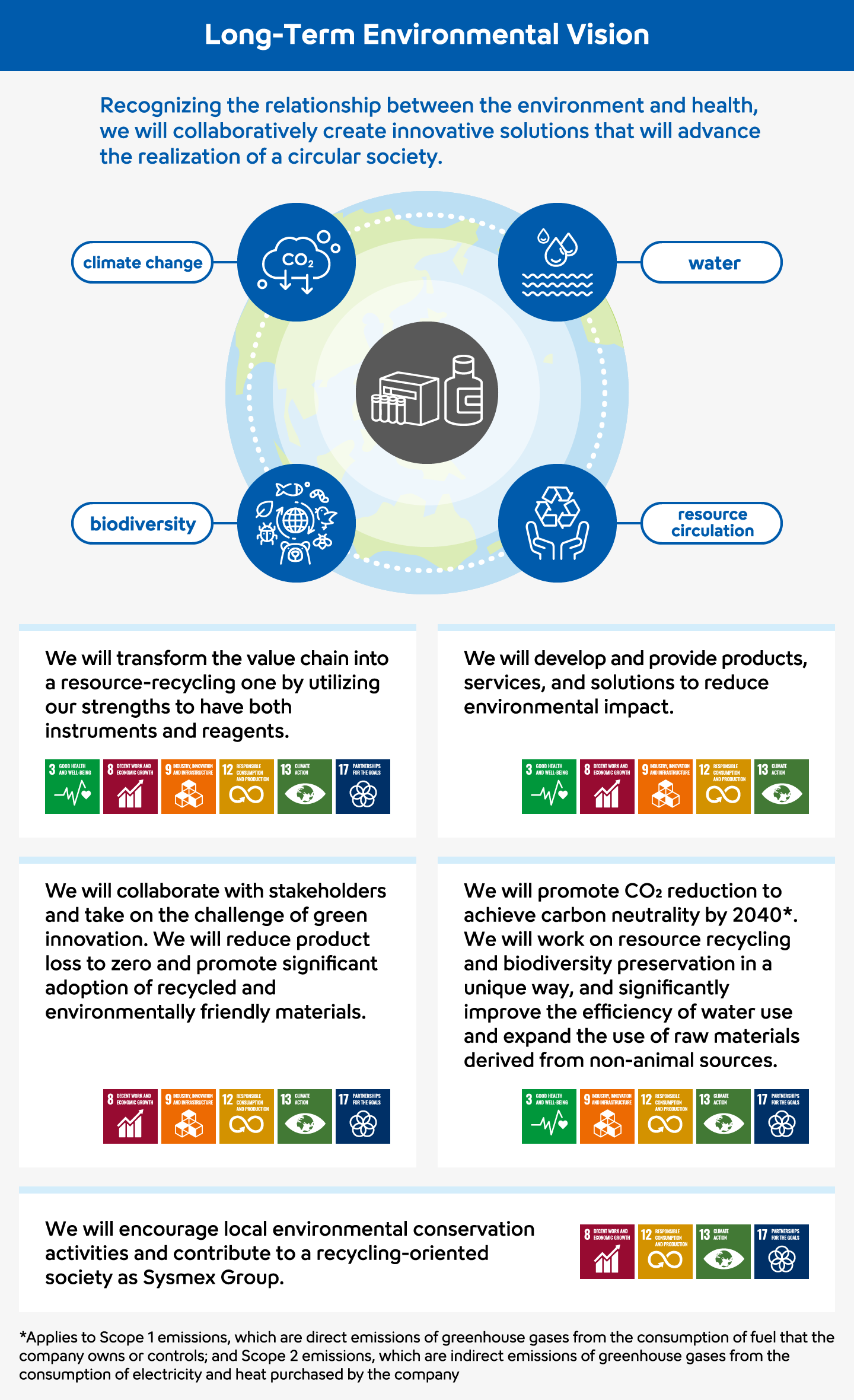
Long-Term Environmental Objectives
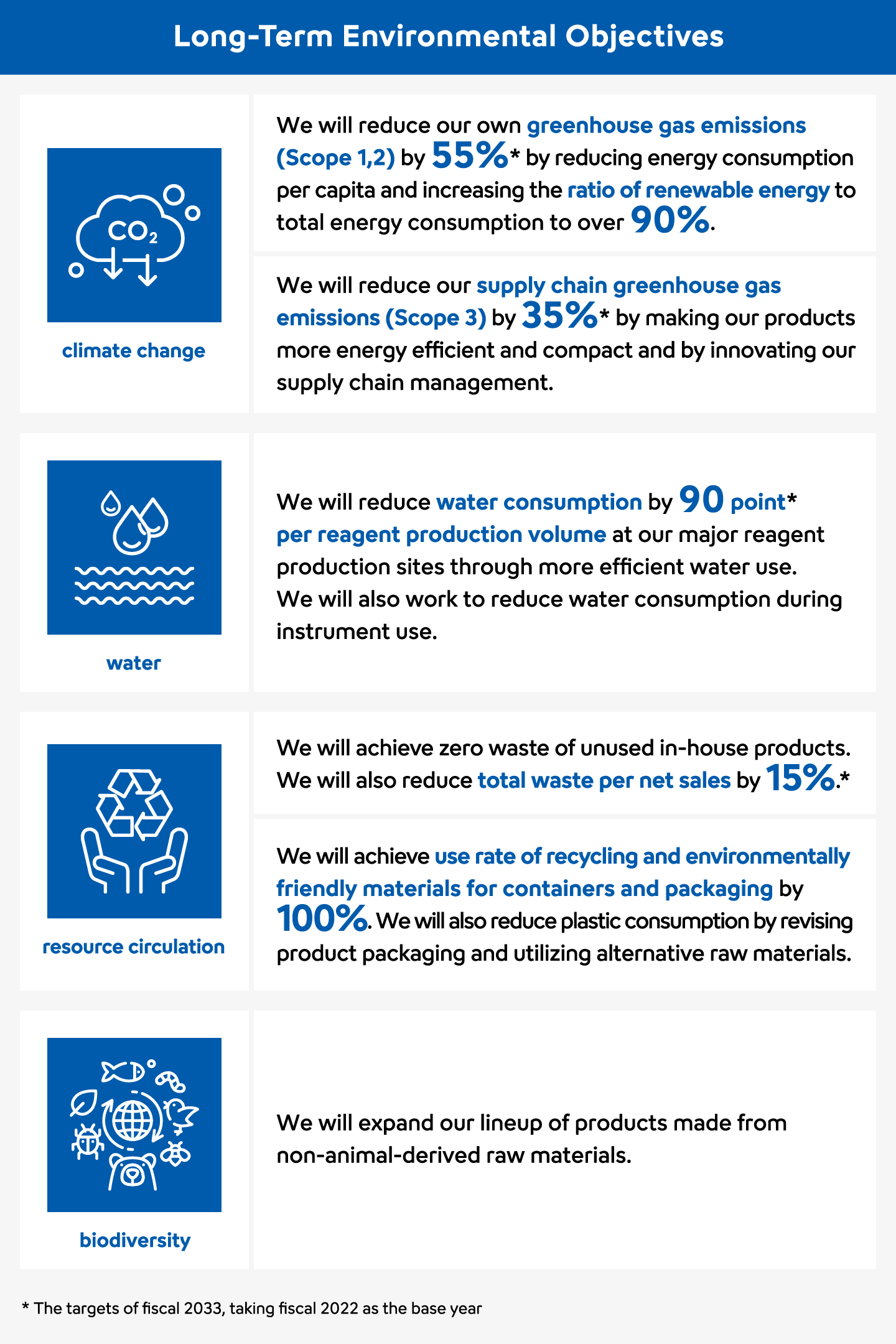
Accreditation of near-term target from SBTi
As part of the “Sysmex Eco-Vision 2033,” Sysmex has set reduction targets for its own GHG emissions (Scope 1 and 2) and its supply chain GHG emissions (Scope 3). Among these targets, the Company’s target to reduce its Scope 1 and 2 emissions by 55% was found to be based on scientific evidence in line with a 1.5°C trajectory, while its target to reduce GHG emissions from use of sold products under Scope 3 by 35% was found to be well below the 2.0°C level. Furthermore, our newly established engagement goal was recognized as promoting 60% of our business partners in purchased goods and services, capital goods, and upstream and downstream transportation and distribution under Scope 3 to have science-based GHG reduction targets within five years.
With the gap between the global GHG emissions reduction and the 1.5°C target of the Paris Agreement, it is expected that further changes in social demands are to come. Seizing the SBTi certification as an opportunity, Sysmex will continue pursuing CO2 emission reductions by changing energy procurement at business locations and how sales and services are performed while promoting resource recycling by adopting environmental considerations materials for products. We will further promote its decarbonization efforts by implementing green innovation based on the ingenuity built by combining the wisdom of the entire Group.
Information Disclosure Based on TCFD・TNFD
Since the adoption of the TCFD recommendations in 2021, Sysmex has been working on climate change initiatives under our Eco-Vision. In July 2025, we adopted the TNFD recommendations, which aim to promote the nature-related risk management and information disclosure, and registered as a TNFD Adopter. By taking an integrated view of issues related to climate change and natural capital, and advancing comprehensive assessments of risks and opportunities, we will strengthen sustainable initiatives based on resource conservation and resource circulation, balancing positive impacts on our business activities with the preservation of the natural environment.
General Requirements Based on TNFD Recommendations
Application of Materiality
In addition to Sysmex’s materiality, which is defined from the perspective of impact on both social and corporate values, we have adopted double materiality that takes into account dependencies and impacts on climate change and natural capital.
Scope of Disclosure
The scope covers not only the Sysmex Group’s business activities but also the entire value chain in assessing risks and opportunities. For natural capital, priority evaluation targets are selected based on resource use and emissions in relation to production volumes, as well as dependencies and impacts in our business activities. Further aspects will be added as appropriate going forward.
Regions with Nature-related Issues
In accordance with the definition of areas requiring attention, we assess our business sites, including adjacent areas using the WWF Biodiversity Risk Filter and the water risk assessment tool, Aqueduct, along with our own environmental performance data. Monitoring is continuously conducted in collaboration with local sites.
Integration with Other Sustainability Issues
Since climate change and natural capital mutually influence one another, we adopt an integrated approach with the disclosures already made under TCFD.
Regional Engagement
Based on our Human Rights Policy, we position consideration for the environment as part of a company’s overall responsibility. In natural capital evaluation, we conduct communication with local governments and other stakeholders in areas surrounding our business sites to confirm and understand the environmental burden on these regions.
Governance
Sysmex promotes initiatives to address environmental issues such as climate change and natural capital through the Environmental Management Committee, which meets regularly under the management and supervision of the Environmental Management Officer (Takashi Ono, Member of the Managing Board and Senior Executive Officer). Activity status and important matters related to the plans are deliberated and decided at management meetings, such as the Steering Committee, under the supervision of the Managing Board.
Strategy
Taking into account integrated scenarios1 under the TCFD and TNFD, which reflect the interrelationship between climate change and natural capital, as well as the Eco-Social Strategy which is the basic strategy for our long-term corporate strategy, Sysmex re-assessed risks and opportunities across all Group businesses2 in 2025. The financial impact of risks and opportunities was evaluated in three stages, based on the impact on operating profit in fiscal 2033. Regarding natural capital, Sysmex applied the LEAP approach recommended by the TNFD to evaluate dependencies and impacts, identifying “freshwater” and “soil” as natural capital to be recognized. We are strengthening initiatives for the conservation and sustainable use of these resources.
- 1 External scenario tools used: AR6 (SSP1-1.9, SSP5-8.5), The IPR FPS + Nature, IEA (STEPS, NZE), Aqueduct Water Risk Atlas.
- 2 The analysis was conducted not only for the Group but for the entire supply chain including upstream (raw material procurement, distribution, etc.) and downstream (use of products, etc.)
Implementation of the LEAP Approach Evaluation
Sysmex conducted an evaluation based on the LEAP approach recommended by the TNFD.
From both the Company’s and external perspectives, we organized the environmental impacts across the product value chain in our diagnostics business, taking into account our business model, sales composition ratio, and industry classification (SICS), and verified geographic information of business sites. We then cross-checked with ENCORE, the SBTN Materiality Screening Tool, and the High Impact Commodity List.
For regional risk evaluation, we utilized the Biodiversity Risk Filter and Aqueduct to identify regions where natural capital could be significantly impacted, extracting freshwater and soil as priority areas of risks and opportunities.
Furthermore, based on the integrated TCFD and TNFD scenarios, we used two quadrants of different temperature ranges and worldviews to assess future impacts. Through discussions with relevant departments based on the results, we confirmed and organized the relationship between business activities in priority regions and natural capital.
Going forward, we will expand the scope of regions subject to evaluation and strategically advance initiatives that contribute to the preservation and restoration of natural capital (freshwater and soil).
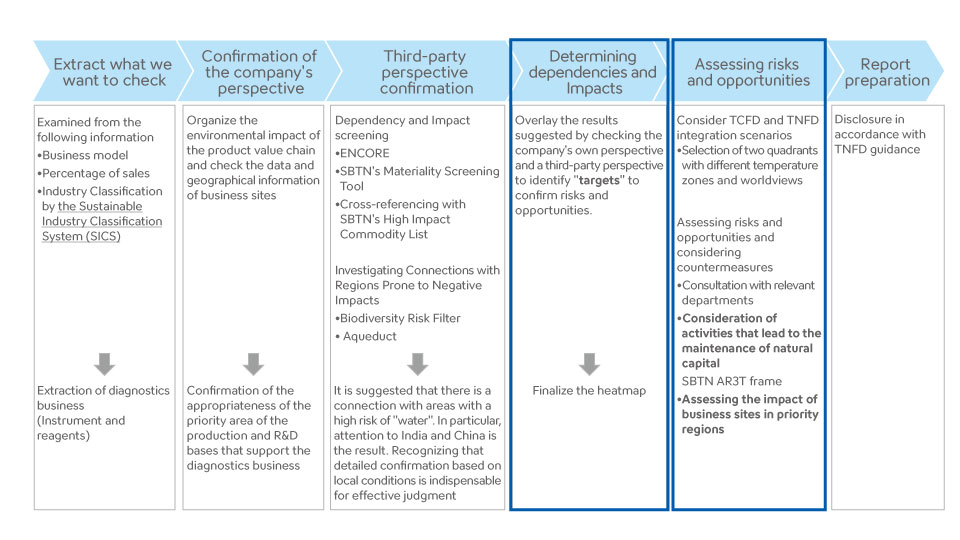
Identification of Dependencies and Impacts
For the extracted target areas, we organized and evaluated, from both the Company’s and external perspectives, the presence and magnitude of dependencies on natural capital and impacts from our business activities.
| Instrument | Reagent | |||
|---|---|---|---|---|
| Dependence | Soil | Soil protection/ Erosion prevention |
- | Middle |
| Fresh water | Groundwater | - | High | |
| Surface water | - | - | ||
| Water cycle | - | Middle | ||
| Ecosystem | Genetic material | - | - | |
| Influence | Resource utilization | Water use | - | High |
| Pollution | Air pollution | - | - | |
| Soil pollution | Middle | Middle | ||
| Solid waste | Middle | Middle | ||
| Water pollution | Middle | Middle | ||
| Obstruction | Noise and light pollution | - | - | |
Based on the organization of dependencies and impacts, we evaluated risks and opportunities using two future scenarios that integrate natural capital and climate change, and examined potential responses. Toward achieving nature-positive outcomes, we organized activities that contribute to the preservation of natural capital under the AR3T framework for natural capital advocated by SBTs for Nature (SBTN).
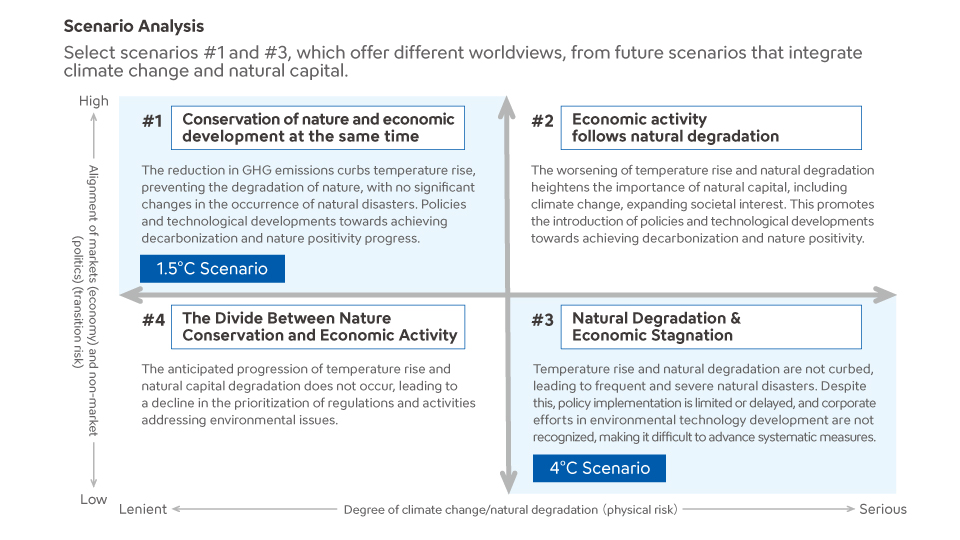
| Risk | Category | Possible Risks1 | Impact period2 Financial impact |
Initiatives1 |
|---|---|---|---|---|
| Transition Risks | ||||
| Policy | Climate change Natural capital |
Product supply will become difficult as a result of the prohibition of certain substances and technologies due to regulatory changes. | Mid- to long-term Low |
RA/QA divisions have been established at each regional headquarters, and respond to the laws and regulations of each country Conduct regular risk assessments of raw materials and ensure a stable supply by considering switching to alternative raw materials. |
| Market | Climate change | Energy and raw material costs, as well as global logistics costs, will increase. | Short- to long-term High |
Reduction of energy costs through the introduction of renewable energy, energy-saving measures and equipment efficiency, expansion of the scope of concentrated reagent products with high transportation efficiency, and development of borderless logistics networks. |
| Technology | Climate change Natural capital |
Shifting to materials and technologies with low environmental impact will lead to an increase in R&D costs and capital investment. It will be difficult to commercialize products that comply with environmental regulations at the expected timing. |
Mid- to long-term Low |
Promote the development of products and technologies based on laws and regulations, customer requirements, and market and industry trends, and systematically replace them with environmentally friendly materials. |
| Reputation | Climate change Natural capital |
Changes in customers' environmental awareness will lead to criticism of the environmental impact of our products and reduce demand. | Mid- to long-term High |
Promote environmentally-friendly planning and design, as well as technological and product development, such as the use of a system that utilizes customer feedback for product development and quality improvement (VOC), and the development of horizontally recyclable reagent containers. |
| Physical Risks | ||||
| Acute | Climate change Natural capital |
Large-scale natural disasters can cause damage to factories and disruptions in supply chains, making it difficult to provide a stable supply of products and services. | Short- to long-term High |
Based on the Business Continuity Plan (BCP), we will build a distributed production system in the vicinity of the consumption area, and diversify risks by securing the purchasing and supply system of raw materials, transportation routes, and securing safety stocks. |
| Chronic | Climate change Natural capital |
Regional shortages of water due to drought will disrupt the stable supply of products. | Mid- to long-term Middle |
Reducing the risk by periodically monitoring water-related risks and establishing BCPs. |
| Opportunity/ Category |
Envisioned Opportunities1 | Impact period2 Financial impact |
Initiatives1 |
|---|---|---|---|
| Resource Efficiency | |||
| Climate change | Optimization of use of transportation methods and operations using IoT. | Short- to long-term High |
Promote CO2 reduction through digitalization of global logistics processes, remote services, and digitization of product-related information such as package inserts and display values. |
| Climate change Natural capital |
Review of packaging and product design will lower raw materials costs and waste. | Short- to long-term High |
We will reduce waste and recycle resources by conserving resources by reviewing packaging materials and forms, replacing them with plastic-free materials, expanding the scope of dry ice-free ultra-low-temperature transportation, reducing product loss to zero, and converting resources discharged in manufacturing and development processes into valuable materials. |
| Energy Source | |||
| Climate change | Reduction of energy costs through energy saving and shifting to low-carbon energy, which will improve social evaluation. | Mid- to long-term Low |
Reduce energy consumption through energy-saving measures, improving the efficiency of facilities, introducing renewable energy, acquiring ZEB certification, switching company cars to fuel-efficient vehicles, and promoting the switch to existing products that consume high electricity. |
| Products & Services | |||
| Climate change Natural capital |
Changes in long-term disease trends due to the deterioration of the natural environment will create new testing opportunities and expand the demand for testing. | Mid- to long-term Middle |
Promote the development of products that contribute to the control of infectious diseases such as malaria and antimicrobial resistance (AMR), and the strengthening of cooperation with public health policies using digital technology. |
| Market | |||
| Climate change Natural capital |
Changes in customers' purchasing attitudes will create opportunities to create new products and services, such as increased demand for environmentally friendly products and products that can be used in any emergency. | Mid- to long-term Middle |
Promote the development of energy-saving and miniaturized products, circular economy products that make use of energy-saving and resource-saving technologies, and extending the shelf life of diagnostic reagents. |
| Reputation Capital | |||
| Climate change Natural capital |
Initiatives on climate change and natural capital and information disclosure will increase evaluation and expectations in financial markets. | Short- to mid-term Low |
Disclosure of environmental information based on TCFD and TNFD compliance, as well as the Sysmex Sustainability Data Book, etc. |
| Resilience | |||
| Climate change Natural capital |
A stable supply of products and services in the event of a natural disaster improves customer trust. | Mid- to long-term Middle |
Implement a global supply system and backup system through multiple raw material procurement measures. |
- 1 Blue text: Added
- 2 short-term: 1 year, mid-term: ~3 years, long-term: ~10 years
Activities that lead to the maintenance of natural capital (freshwater and soil)
| SBTN AR3T Classification* | Maintenance of water resources | Maintenance of soil function |
|---|---|---|
| Avoid | - |
|
| Reduce |
|
|
| Restore・Regenerate | - |
|
| Transform | Development of environmentally friendly technologies and green impact products | |
- SBTN AR3T:Act – Science Based Targets Network
Management of Risks and Impacts
From a mid- to long-term perspective, the Environmental Management Committee identifies significant environmental risks with potentially high impacts on business once every few years and implements countermeasures. The results are reported at the management meetings, chaired by the President, and are incorporated into the companywide risk evaluation led by the Internal Control Committee.
Metrics & Targets
Sysmex has set forth Sysmex Eco-Vision 2033 and sustainability targets to promote the non-financial goals defined in the “Declaration of Achieving Carbon Neutrality by 2040”* and in the long-term corporate strategy, which runs through the fiscal 2033.
With respect to natural capital, indicators and targets are determined in line with the TNFD recommendations, reflecting the results of the evaluations conducted through the LEAP approach. These are integrated into the Company’s overall non-financial targets and centrally managed together with other environmental goals.
Specifically, Sysmex has established the following: reduction of greenhouse gas emissions as a climate change-related target; reduction of water consumption per unit of reagent production volume at major reagent production sitesas a natural capital-related target; elimination of product loss (keeping the disposal rate of unused Sysmex products below 0.1%); and complete substitution with recycled or environmentally friendly materials. Sysmex will continue advancing initiatives across all stages of the product lifecycle—from R&D through production, logistics, and disposal.
- Targeting net zero greenhouse gas emissions from Group business sites by 2040 (Scope 1 and Scope 2).
Environmental Management System
Group Environmental Management System
Status of ISO 14001 Certification
Sysmex is working toward the acquisition of ISO 14001, the international standard for environmental management systems, by the Group's principal affiliated companies.
As of March 31, 2025, 20 Group companies had acquired ISO 14001 certification, and these companies account for approximately 70% of the net sales of the Group.
By centralizing the environmental activities of certain Group companies, we are working to ascertain the state of progress on activities and issues as well as reinforcing management activities, and three companies (Sysmex Corporation, Sysmex RA, and Sysmex Medica), accounting for nine locations, have obtained integrated certification. As a result, we are now able to systematically share information related to environmental management.
List of ISO14001 Certified Locations
| Region | Company |
|---|---|
| Japan | Sysmex Corporation, Sysmex Medica, Sysmex RA |
| Americas | Sysmex America, Sysmex Reagents America, Sysmex Brazil |
| EMEA* | Sysmex Europe, Sysmex Deutschland, Sysmex France, Sysmex Espana, Sysmex UK, Sysmex Belgium, Sysmex Nederland, Sysmex Nordic, Sysmex Hungaria |
| China | Sysmex Wuxi, Jinan Sysmex |
| AP | Sysmex Asia Pacific, Sysmex India, Sysmex Australia |
- EMEA: Europe, the Middle East, and Africa
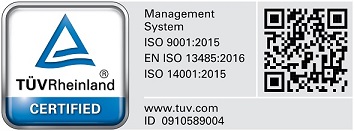
Conducting Environmental Auditing
In line with environmental management system requirements, we perform regular internal and external environmental audits at locations that have obtained ISO 14001 certification. In fiscal 2024, there were zero cases of nonconformities in both internal environmental audits and external environmental audits at our domestic Group locations with integrated certification.
Environmental Education
Conducting Environmental Education and Training
Sysmex conducts general education for all employees to foster an awareness of the impact of the Group’s environmental activities and individual operations. We conduct specialized training to raise operational knowledge for individuals designated by their divisions as personnel responsible for environmental management system promotion. We also conduct specialized and emergency response training for each division, as necessary.
In fiscal 2024, we provided general environmental e-learning training for all employees at our business offices with integrated ISO certification. We also held seminars on laws and regulations for staff members in charge of business offices and those in the product lifecycle departments.

